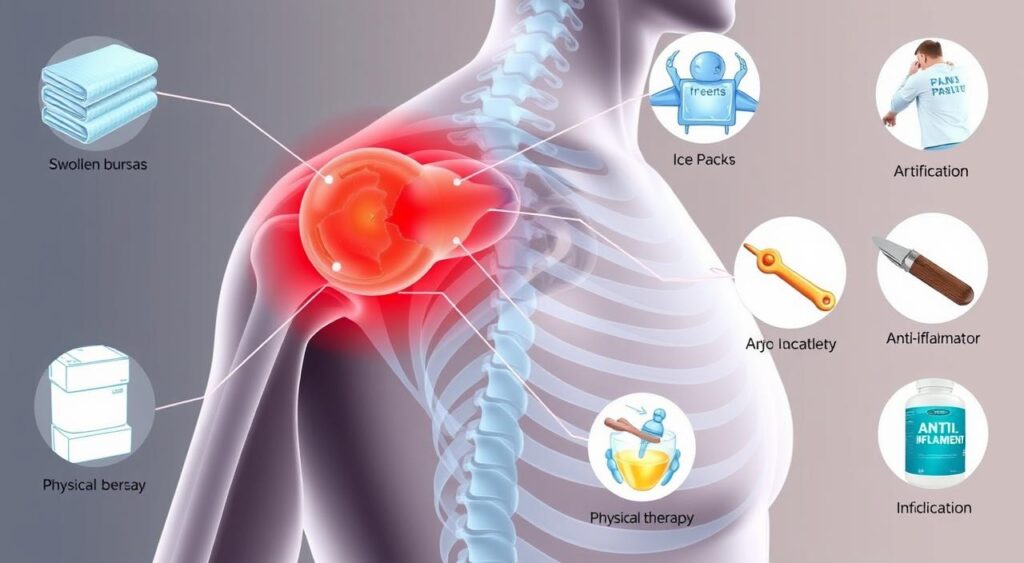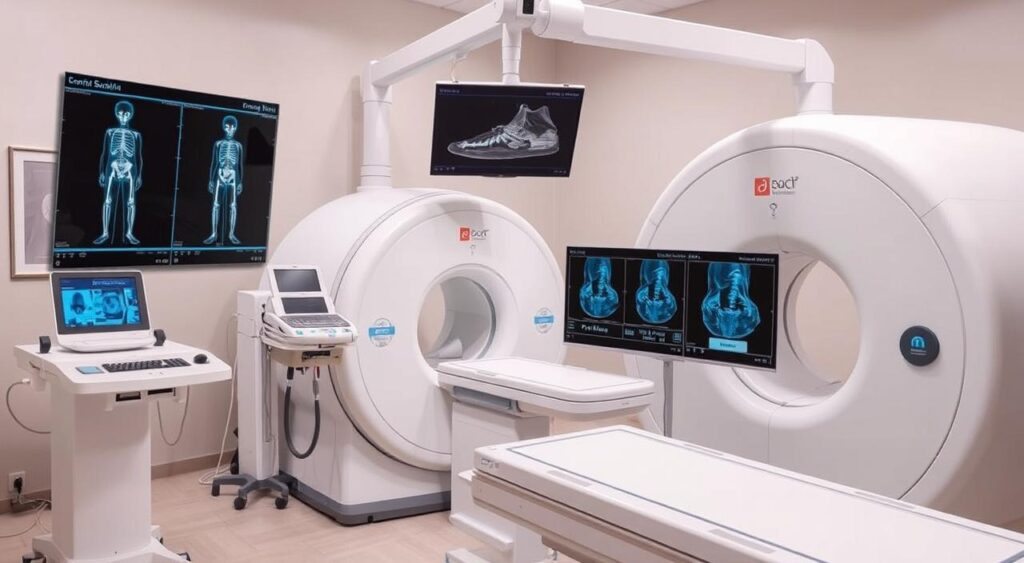Explore the causes and symptoms of Bursitis, along with effective treatment options for relief and prevention. Learn more about managing this condition.
Did you know that about 1 in 10 adults will get bursitis at some point? This common condition is when the bursa, a small fluid-filled sac, gets inflamed. It’s important to know about bursitis for those affected and for doctors to treat it well. We’ll look at what causes bursitis, its symptoms, and how to treat it. This will help both patients and doctors manage it better.

Key Takeaways
- Bursitis affects a significant portion of adults, highlighting its widespread nature.
- Understanding bursitis can aid in timely diagnosis and effective treatment.
- The bursa serves a critical role in cushioning joints and reducing friction.
- Recognizing bursitis symptoms early can lead to better management outcomes.
- Both non-surgical and surgical bursitis treatment options are available for relief.
Understanding Bursitis
Bursitis is when the bursa, a small sac filled with fluid, gets inflamed. It cushions bones, tendons, and muscles near joints. Knowing what bursitis is starts with understanding its bursitis definition. It usually happens when the bursa gets irritated or inflamed from too much motion or pressure.
It often affects places like the shoulders, elbows, hips, and knees. Knowing the different types of bursitis is key to treating it right. For example, subacromial bursitis in the shoulder and olecranon bursitis in the elbow show how location affects symptoms.
Looking into the causes of bursitis helps in finding ways to prevent it. Learning about the anatomy and function of bursae helps us understand why it happens. This knowledge is crucial for managing symptoms and improving daily life.
What Causes Bursitis?
Bursitis can come from many sources. Knowing what causes it helps in managing and stopping it. Age, lifestyle, and health issues play big roles in getting bursitis.
Common Risk Factors
There are several key risk factors for bursitis:
- Age: Older adults are more at risk because their body’s tissues wear down.
- Obesity: Being overweight puts more pressure on bursae, making inflammation more likely.
- Occupational hazards: Jobs that involve repetitive motions, like plumbing or construction, can cause strain.
- Pre-existing conditions: People with arthritis, diabetes, or gout are more likely to get bursitis because of joint problems.
Injury and Overuse
Injuries and repetitive actions are big causes of bursitis. Falls or direct hits can inflame bursae right away. On the other hand, doing the same thing over and over can slowly irritate them.
For example, athletes often get shoulder bursitis from overhead movements. Typing for a long time can lead to wrist bursitis. Spotting these patterns early can help stop things from getting worse.
Recognizing Bursitis Symptoms
Bursitis can cause many symptoms that are important to spot early. Knowing these symptoms helps in getting the right treatment. It’s key to understand the signs of different bursitis types to find the cause.
Identifying Pain Areas
Finding where the pain is helps in diagnosing bursitis. Common pain spots include:
- Shoulder: Pain gets worse when lifting or reaching up.
- Elbow: Pain is on the outer side of the joint.
- Knees: Pain happens when squatting or kneeling.
- Hip: Pain is felt when walking or sitting for a long time.
These pain spots can change based on the bursitis type. So, it’s vital to pay close attention.
Other Symptoms to Watch For
There are other signs of bursitis besides pain. Knowing these symptoms helps understand the condition better:
- Swelling: Swelling around the joint.
- Stiffness: Less movement in the joint, making daily tasks hard.
- Redness and Warmth: Skin over the joint might look red and warm.
Spotting these signs early helps in getting the right treatment sooner.
Diagnosis of Bursitis
Getting a correct bursitis diagnosis is key for good treatment. It starts with a detailed physical check-up. Doctors look at the joint’s function, checking for swelling, tenderness, and how well it moves.
Physical Examination Techniques
Doctors use special ways to find where the pain is coming from. They do:
- Palpation: They feel the joint area to find tenderness and swelling.
- Range of Motion Testing: They check how flexible and movable the joint is.
- Strength Testing: They test the muscles around the joint.
This careful check helps find bursitis and rule out other possible causes of pain.
Imaging Tests for Confirmation
If the physical check shows bursitis, imaging tests help confirm it. Common tests are:
- X-rays: They help check for fractures or other issues.
- Ultrasound: It shows the bursae and tissues around them in real-time.
- Magnetic Resonance Imaging (MRI): It gives detailed images of soft tissues, showing inflammation or damage.

Knowing how these tests work helps understand bursitis better. It also helps make a good treatment plan.
Bursitis Treatment Options
Treatment for bursitis can vary a lot. It depends on how bad the condition is. A mix of methods often works best for managing symptoms and helping the body heal. Knowing the different ways to treat bursitis is key for effective pain relief and long-term care.
Medications for Pain Relief
Anti-inflammatory drugs, like ibuprofen and naproxen, are often suggested. They cut down inflammation and ease pain. For more serious cases, doctors might prescribe stronger pain meds or corticosteroid shots. These can greatly reduce swelling and pain if used right.
Non-Surgical Treatments
Many non-surgical treatments help manage bursitis well. Resting the area is important for healing. Ice can also help lessen swelling and ease pain right away.
Physical therapy is another key part. It strengthens muscles around the inflamed bursa. This improves joint function and lowers the chance of future problems. Using braces or supports can also aid in recovery.
Physical Therapy for Bursitis
Physical therapy is key in treating bursitis. It helps more than just ease pain. It also helps restore function and movement in the affected area. Working on the muscles around the bursa can prevent stiffness and aid in recovery.
Benefits of Bursitis Exercises
Regular bursitis exercises bring many benefits. These include:
- Pain Reduction: Moving around can lessen pain and improve joint health.
- Increased Range of Motion: Exercises keep the joint flexible, ensuring it works well.
- Enhanced Muscle Strength: Strengthening the muscles around the bursa helps with support and stability.
- Stiffness Prevention: Regular activity stops muscles and joints from getting stiff.
Recommended Physical Therapy Techniques
Using the right techniques for bursitis can speed up recovery. Some good methods include:
- Stretching exercises to boost flexibility.
- Strengthening exercises for the muscles around the joint.
- Range of motion activities for the specific joint affected by bursitis.
Seeing a licensed physical therapist can help create a plan that fits your needs. This can make physical therapy more effective.

| Technique | Purpose | Frequency |
|---|---|---|
| Stretching | Improve flexibility | Daily |
| Strengthening | Enhance support | 3-4 times a week |
| Range of Motion | Restore movement | 2-3 times a week |
Preventing Bursitis
To prevent bursitis, making lifestyle changes and ergonomic adjustments is key. These steps help lower the risk of this painful condition.
Essential Lifestyle Changes
Regular exercise strengthens muscles and boosts flexibility. A balanced fitness plan is crucial for joint health. Eating well helps keep your weight in check, easing joint pressure.
Low-impact activities like swimming or cycling are great for joints. They help prevent bursitis by reducing inflammation.
Ergonomic Adjustments in Daily Activities
Improving your workspace ergonomics is important. Use supportive chairs and adjust your desk for better posture. This reduces pressure on sensitive areas.
Regular breaks from sitting or standing help your joints. This practice is key to preventing bursitis.
Starting with warm-up exercises before activities can prevent injuries. This prepares your muscles and joints for what’s ahead. Adapting your daily routine to support your health reduces bursitis risk.
| Lifestyle Changes | Benefits |
|---|---|
| Regular Physical Activity | Strengthens muscles, improves flexibility |
| Healthy Diet | Maintains ideal weight |
| Low-Impact Exercises | Reduces strain on joints |
| Warm-up Exercises | Prepares muscles for activity |
Managing Bursitis Effectively
Managing bursitis means focusing on pain relief, physical therapy, and lifestyle changes. It’s important to work together with healthcare professionals. This teamwork helps create treatment plans that fit each person’s needs.
It’s key to watch symptoms closely and follow treatment plans. Regular visits to doctors or physical therapists are important. They help see how you’re doing and change plans if needed. Using long-term management methods can make you feel better and prevent future problems.
- Regular physical activity tailored to the specific affected area.
- Incorporation of anti-inflammatory medications as advised by a doctor.
- Education on ergonomics and proper body mechanics to prevent future flares.
- Commitment to follow-up appointments for continuous assessment and guidance.
A good management plan can greatly improve life for those with bursitis.
| Management Strategy | Description | Benefit |
|---|---|---|
| Physical Therapy | Targeted exercises to improve strength and flexibility. | Reduces pain and increases mobility. |
| Medication | Use of nonsteroidal anti-inflammatory drugs (NSAIDs). | Alleviates inflammation and pain. |
| Activity Modification | Adjusting movements to decrease joint stress. | Prevents exacerbation of symptoms. |
| Regular Monitoring | Frequent assessments by healthcare providers. | Ensures ongoing effectiveness of the management plan. |
| Ergonomic Changes | Adapting environments to reduce strain. | Enhances comfort during daily activities. |
Home Remedies for Bursitis Relief
Many people look for home remedies to ease bursitis pain and swelling. Simple methods like ice therapy can help a lot. Adding natural anti-inflammatories to your diet also helps manage pain.
Ice and Compression Techniques
Ice therapy is great for reducing bursitis inflammation. Use an ice pack or a frozen bag wrapped in a towel for 15 to 20 minutes, several times a day. This numbs the area and reduces swelling.
Using compression wraps also helps. They apply gentle pressure, which can help reduce swelling.
Natural Anti-Inflammatory Options
Eating foods with anti-inflammatory properties can help with bursitis symptoms. Turmeric and ginger are good examples. They can reduce discomfort and support healing.
Adding these foods to your diet or taking them as supplements is beneficial. Using home remedies for bursitis can help you manage symptoms better.
Long-term Outlook for Bursitis Sufferers
Living with bursitis can be different for everyone. Some people may have it for a long time, needing special ways to manage it. It’s important to know what triggers your bursitis to make a treatment plan that works for you.
Living with Chronic Bursitis
Managing bursitis long-term means taking care of yourself and knowing your symptoms. Many people find help in physical therapy, changing their lifestyle, and taking the right medicine. Creating a routine with exercise and rest can improve your life a lot.
When to Seek Medical Help
It’s key to know when to see a doctor for bursitis. If your symptoms don’t get better or get worse, you should get checked out. Doctors can offer better treatments and help prevent serious problems, keeping your quality of life good.
| Trigger Factors | Management Strategies |
|---|---|
| Repetitive Activities | Modify routine tasks and integrate breaks |
| Injury History | Focus on rehabilitation through physical therapy |
| Age-related Changes | Engage in regular low-impact exercises |
| Obesity | Adopt a weight management plan |
Conclusion
Bursitis is a condition that can be managed with the right approach. Knowing its causes, symptoms, and treatments helps people take care of themselves. This summary shows how important it is to act early and manage bursitis well.
Preventing bursitis is key. Making lifestyle changes and using ergonomic tools can help a lot. Also, using the right rehabilitation methods can bring lasting relief. Personalized treatment plans are crucial for each person’s needs.
Following good advice on managing bursitis can greatly improve your life. It lets you stay active and enjoy life more. Knowing how to handle bursitis is the first step to a healthier, happier life.
FAQ
Q: What is bursitis?
A: Bursitis is when the bursa, a small fluid-filled sac, gets inflamed. It cushions bones, tendons, and muscles near joints. This can cause pain and limit movement.
Q: What are the common symptoms of bursitis?
A: Symptoms include swelling and tenderness in one spot. You might feel pain when moving or applying pressure. The joint can also feel stiff.
Other signs are redness and warmth in the area.
Q: What causes bursitis?
A: It’s often caused by doing the same thing over and over, or by injuries. Certain health conditions like arthritis or diabetes can also play a part. Age and job can influence it too.
Q: How is bursitis diagnosed?
A: A doctor will first check the joint for tenderness and movement. They might use X-rays or MRI to confirm the diagnosis and check for other issues.
Q: What are the treatment options for bursitis?
A: Treatments include pain-relieving medicines and rest. Applying ice and getting corticosteroid injections can also help. Physical therapy is used to strengthen muscles around the joint.
Q: Can physical therapy help with bursitis?
A: Yes, physical therapy is very helpful. It improves joint movement and strength. It also prevents stiffness with specific exercises and techniques.
Q: How can bursitis be prevented?
A: To prevent bursitis, keep a healthy weight and exercise regularly. Make sure your workspace is set up right. Avoid putting too much stress on your joints.
Q: Are there home remedies for bursitis relief?
A: Home remedies like ice and compression can help with swelling and pain. Turmeric and ginger might also help. Always talk to a doctor for the best care.
Q: What is the long-term outlook for someone with bursitis?
A: The outlook for bursitis varies. Some may have it for a long time. But, managing it well can improve your life and reduce flare-ups.
Q: When should I seek medical help for bursitis?
A: If your symptoms don’t get better or get worse, see a doctor. They can check for other issues and find more treatment options.
